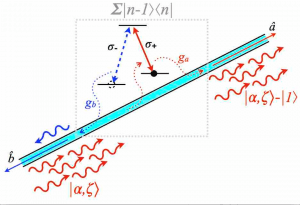Summary
This project develops new sources of light that utilize quantum entanglement to enhance imaging resolution and detection. We aim to go beyond simple photon pairs and advance our understanding and control of new quantum states of light. Our approach uses deterministic single-photon subtraction (removing of a specific photon from a pulse of light) implemented with three-level solid-state quantum emitters, such as quantum dots and colour centers in diamond, coupled to chiral waveguides. In this type of waveguide, light propagation direction is determined by light’s polarization. Our goal is to cascade multiple photon subtraction stages on a chip-scale device and explore deterministic photon subtraction as a tool for engineering quantum states of light for improved resolution of optical microscopy and long range optical sensing.

Figure 1. A three-level quantum emitter with circularly polarized transitions between its ground and excited states is strongly coupled to a chiral waveguide to form a device that can deterministically subtract single photon from input light. This can be used to generate highly non-classical states from, e.g., squeezed coherent states.
Related Content

Zero-Dimensional Quantum Materials for the Next Generation of Highly-Selective Chemical Sensors
Summary Heavy metals are a major public health concern and their on-site detection in water supplies is not well served by existing lab techniques. We develop a new multi-modal platform comprising functionalized quantum dots of two-dimensional materials (2D-QDs) for the sensing of four highly-toxic heavy metal pollutants (arsenic, cadmium, lead and mercury). The zero-dimensional […]
March 11, 2019

On-Chip Microwave-Optical Quantum Interface
Summary In this project we develop a quantum interface between microwave and optical photons as a key enabling technology of a hybrid quantum network. In such a network, the robust optical photons carry quantum information through optical fibres over long distances, while superconducting microwave circuits protected from thermal photon noise by the low temperature […]
October 29, 2018

Mesoscopic systems as coherent control elements
Summary Mesoscopic systems provide a new tool for quantum systems design. In particular, they are enabling of robust quantum control. Here “mesoscopic system” refers to a connected network where each element, if studied alone, would be a quantum bit. The network is too big to be treated fully quantum mechanically. We do not have individual […]
September 1, 2016

Novel Infrared Camera Based on Quantum Sensors for Biomedical Applications
Summary In this project we develop a novel infrared camera with low noise and high detection efficiency for biomedical applications of optical coherence tomography (OCT) using quantum materials. OCT is a technique used to image the back of the eye and allow for the diagnosis of detrimental eye conditions, for e.g., macular degeneration, diabetic retinopathy […]
March 13, 2019

